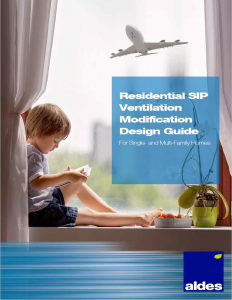 The Aldes Residential SIP Ventilation Modification Design Guide (PDF) is a comprehensive handbook of best practices for ventilating single- and multi-family homes. Developed as a result of American Aldes’s involvement with Residential Sound Insulation Programs (SIP) across the country, this guide explains how homes that are tightly built (like those in areas surrounding airports) can suffer from poor indoor air quality.
The Aldes Residential SIP Ventilation Modification Design Guide (PDF) is a comprehensive handbook of best practices for ventilating single- and multi-family homes. Developed as a result of American Aldes’s involvement with Residential Sound Insulation Programs (SIP) across the country, this guide explains how homes that are tightly built (like those in areas surrounding airports) can suffer from poor indoor air quality.
Tight buildings are similar to air in a sealed plastic bag. Unwanted pollutants such as odors, humidity, airborne chemicals, and gases are trapped inside. In fact, a tight building is worse than a sealed plastic bag since the building occupants are adding additional pollutants to the air constantly. Without controlled ventilation, pollutants build up in tight buildings, causing physiological harm to the occupants and structural damage to the building. Whole-building ventilation – the exchanging of stale indoor air with fresh outdoor air – is necessary to maintain a healthy living environment. Continuous ventilation removes and dilutes pollutants not captured by local (source) ventilation, as well as pollutants that occur in rooms other than bathrooms or kitchens.
The Aldes Residential SIP Ventilation Modification Design Guide describes the problems with tight buildings, explains ventilation standards in the United States, and dispels common ventilation misconceptions. Recommendations are broken down by ASHRAE Climate Zone and existing ventilation scenario because one ventilation strategy does not fit all situations. The ventilation strategies in this guide are the product of American Aldes’s more than 30 years providing engineered solutions to improve occupant comfort and save energy.
To learn more about Aldes products, visit Residential System Solutions, Ventilate Better, or contact Aldes directly.

